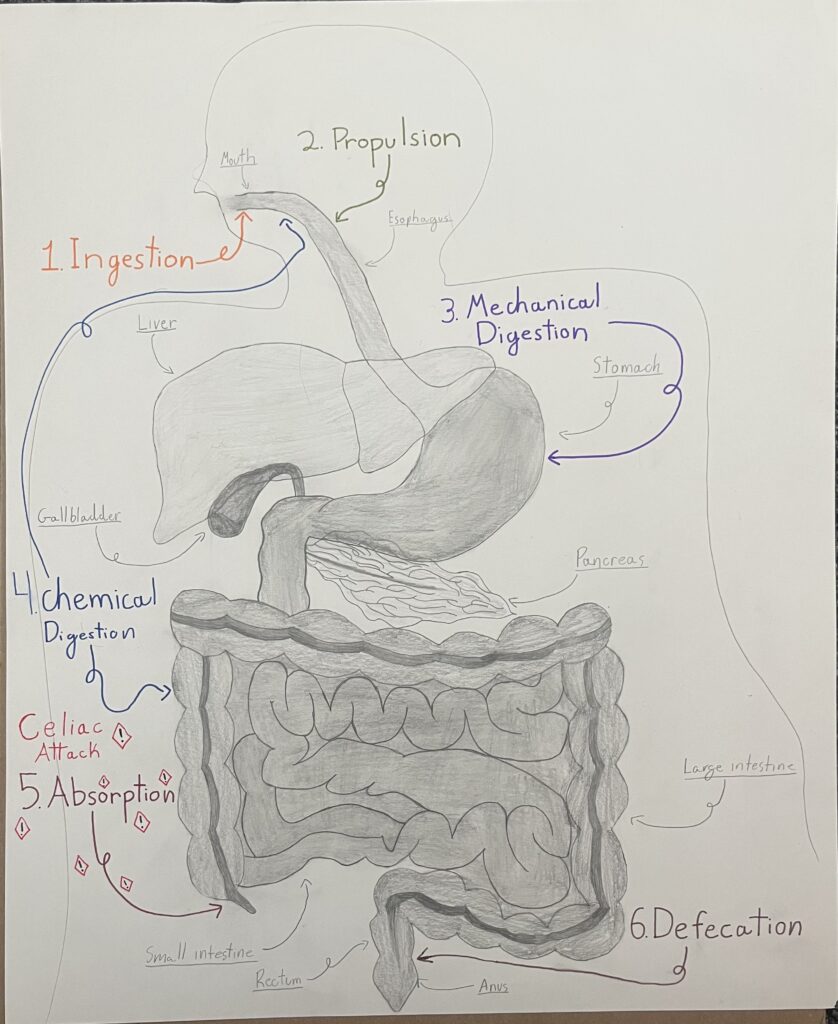Kintla Penn
A&P, BIOL F112X
Steam Project
April 13th, 2024
Celiac Attack
The digestive system involves a group of organs working together to break down food, absorb nutrients, and eliminate waste products. Learning about the organs involved and the sequential steps of digestion will help us better understand this crucial bodily function.
The first step of the digestion process is ingestion, which involves taking food into the mouth. The mouth, which has salivary glands, starts the digestion process by mixing the food with saliva containing enzymes that primarily break down carbohydrates. Chewing helps break the food into smaller particles, making it easier for the subsequent stages of digestion.
Step 2 in the digestion process is propulsion, which refers to food movement through the digestive tract after ingestion. When we swallow, the chewed food is propelled into the esophagus, where involuntary muscular contractions known as peristalsis push it toward the stomach. This movement ensures that the food progresses continuously along the digestive tract.
The third step of the digestive process is mechanical digestion, which mainly takes place in the mouth and stomach. In this step, food is physically broken down into smaller pieces without altering its chemical composition. Chewing the food increases its surface area in the mouth, while contractions in the stomach further mix and churn the food with digestive juices, forming chyme—a semi-liquid substance.
Chemical digestion is the fourth step. It begins in the mouth and continues in the stomach and small intestine, where complex food molecules are broken down into simpler forms. Various organs, such as the salivary glands, stomach, pancreas, and liver, secrete enzymes and acids that catalyze this process. Proteins, fats, and carbohydrates are broken down into amino acids, fatty acids, and sugars to facilitate their absorption.
That leads us to the fifth step, absorption, which mainly occurs in the small intestine. During this process, nutrients are absorbed into the bloodstream or lymphatic system and then distributed to the cells throughout the body. The intestinal walls have villi and microvilli that increase the surface area for absorption, making the nutrient uptake more efficient. Water, vitamins, minerals, and nutrients are also absorbed during this process, which helps support the body’s functions and promote energy production.
The final step is defecation, which involves the elimination of indigestible substances and waste products from the body. The colon and rectum absorb water from the remaining digested food, forming solid feces. The movement of feces towards the rectum is facilitated by peristaltic contractions, which eventually signal the urge to defecate (poop). The release of feces through the anus is controlled by the anal sphincters, thereby completing the digestive process.(Jackson-Osagie, 2022)(Professional, 2021)
Where it can go wrong, though, is when celiac attacks. Celiac disease, also known as celiac sprue, can cause severe problems for the digestive system, especially during the absorption process in the small intestine. When gluten, a protein found in wheat, rye, and barley, is consumed by someone with celiac disease, their immune system attacks the small intestine’s villi, which are responsible for absorbing nutrients. The villi, similar to a plant’s roots, are damaged by the immune response, making it difficult for the small intestine to absorb nutrients from food properly. This can lead to various unpleasant symptoms, including abdominal discomfort, bloating, and malnutrition.(Professional, 2021)(Celiac Disease Can Harm Digestion – Health Encyclopedia – University of Rochester Medical Center, 2024)
Sources:
Celiac Disease Can Harm Digestion – Health Encyclopedia – University of Rochester Medical Center. (2024). https://www.urmc.rochester.edu/encyclopedia/content.aspx?contenttypeid=56&contentid=2418
Jackson-Osagie, E., Anspaugh, K., Smith, S. Q., & Goncalves, S. (2022). Physiology of the Digestive System. Pressbooks. https://louis.pressbooks.pub/medicalterminology/chapter/digestive-physiology/#:~:text=The%20processes%20of%20digestion%20include,alimentary%20canal%20through%20the%20mouth.
Professional, C. C. M. (2021). Digestive System. Cleveland Clinic. https://my.clevelandclinic.org/health/body/7041-digestive-system


It took me a minute to find your project… lol, I had to ask Jacqui but I really love your idea of writing about celiac. What made you choose this condition? Did it just interest you or do you know someone who suffers from this? No need to name who, if so, but the most interesting part was how you described each part of the digestive system in the steps, or process, on how it happens in our body including the difference between mechanical and chemical digestion. Because I do agree that we wouldn’t be able to understand what celiac disease was until we knew these steps due to it mostly affecting the small intestines area. But I do think you could have written an extra paragraph about celiac, just giving more details, because that was the focus point of your project but in the one paragraph you have, you seem to describe this condition pretty well. Well enough for me to have a picture in my head of what it is and how it’s involved with our digestive system. I also wish that you put a title in for your project, so then it could grasp your audience more. But overall, your writing was informative and organized and I really love your drawing, showing all the parts of our digestive track and labeling each part, even where the celiac attack happens. It was good that you also listed your sources at the end. Last year I forgot to put my sources online but had them in my essay lol. But hope you had fun with this project, and you have a great summer! 🙂